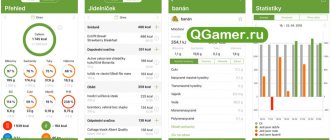An experienced nutritionist and nutrition consultant must first of all be able to do two things: calculate the daily calorie requirement, correctly distribute proteins, fats and carbohydrates within a given caloric intake.
All these values are calculated using certain formulas, and sometimes some difficulties arise with this. At the School of Dietetics at the Academy of Wellness Consulting
They teach this in great detail. And today we will tell you in simple language how to carry out the necessary calculations and not get confused in the numbers...
How to calculate your daily calorie intake?
Calorie intake depends on many factors and will be different for each person. Of course, sometimes nutrition consultants resort to averages or use data obtained by weighing a client on a body composition analyzer scale. However, if you want the menu you have compiled to be truly individual and accurate, then it is better to use the appropriate formula.
To calculate, you need to know the weight, height, gender and age of the person for whom the daily caloric intake is determined, as well as the level of physical activity. Much depends on the last indicator, since people leading an active lifestyle require more energy to function.
Don’t forget about the ambient temperature: the basic calorie intake is calculated taking into account comfortable temperature conditions; in cold weather, the energy value of food can be slightly increased, and in hot weather, on the contrary, reduced (by about 10%).
Now let's move directly to the formula for calculating the daily calorie requirement (DC):
SPK = (BOOV + SDDP) × KFA
Let's decipher the abbreviation:
- DAC – daily calorie requirement;
- BOOV – basal metabolic rate;
- SDDP – specific dynamic effect of food;
- KFA – physical activity coefficient.
Is it more convenient to get information about calculating calorie intake from a video? Then watch how to calculate the SPC in a video lecture from a sports medicine doctor and an expert at our school of nutritionists, Yuri Butria:
To make calculations using this formula, you must first find out all the quantities present in it:
Basal metabolic rate (BMR)
This is the amount of energy that the body requires to function in comfortable temperature conditions and a calm state. This indicator depends on the weight, height, gender and age of the client. As you know, men have a slightly higher basal metabolism than women, so the formulas for both sexes are also different.
To calculate BOOB, we recommend using the Mifflin-San Geor formula, the most common among nutritionists. It looks like this:
MIFFLIN-ST JEORA FORMULA
FOR WOMEN: BOOV = 9.99*WEIGHT (KG) + 6.25*HEIGHT (CM) – 4.92*AGE (YEAR) – 161
FOR MEN: BOOV = 9.99*WEIGHT (KG) + 6.25*HEIGHT (CM) -4.92*AGE (YEAR) + 5
Carefully plug all the values into the above formula and get the client's basal metabolic rate.
Specific dynamic action of food (SDAF)
This is the amount of energy that the human body needs to chew and digest the food eaten, as well as to transport nutrients from it.
As a rule, this indicator is 10% of the basal metabolism, so it is very easy to calculate it using this simple formula: ADDP = 10% * BOOV
Physical Activity Quotient (PFA)
It is clear that the level of physical activity may be different every day, but only because of this no one will constantly recalculate the daily calorie requirement. So, when determining this indicator, you should rely on the average result and use the already developed CFA table (at our school of nutritionists we carry out calculations using the same table):
TABLE OF PHYSICAL ACTIVITY RATIOS
| Minimal physical activity (sedentary work) | 1,2-1,3 |
| Light daily activity or light exercise 1-3 times a week | 1,4-1,5 |
| Workout in the fitness room 4-5 times a week or moderate work | 1,6-1,7 |
| Intense training 4-5 times a week | 1,8-1,9 |
| Daily workouts | 2-2,1 |
| Daily intense workouts or regular workouts 2 times a day | 2,2-2,3 |
| Intense training 2 times a day or heavy physical work | 2,4-2,5 |
Now calculate each indicator separately and substitute them into the general formula for calculating the daily calorie requirement (DC). Remember that the result shows how much energy the client’s body needs every day. If you stick to it, your weight will stabilize, since the intake of calories from food will correspond to their expenditure.
Tricks to “fit into the norm”
To get your daily calorie intake for weight loss, you can, of course, eat a piece of cake and a couple of chocolate bars, and suffer from hunger the rest of the day. But there is another option: eat foods with medium or low calorie content in order to feel full for a long time and provide the body with all the necessary nutrients.
This will also help make the weight loss process as comfortable as possible. In order not to go on a diet and always stay slim, experts recommend following a number of rules:
- Remove fatty foods from your diet. To do this, simply find an alternative. For example, instead of pork, eat lean beef or steam the cutlets not in oil, but in steam. Your satiety level will remain the same, but the number of calories consumed will decrease significantly.
- No sugar. Cravings for sweets can be muffled with a reasonable amount of honey, dried fruits and dark chocolate.
- Chewing food thoroughly. Slowing down the process of food entering the digestive tract can fill the body faster and, as a result, reduce portions. Fractional meals. Dividing portions into 5-6 meals will help reduce stomach volume, which will reduce the risk of overeating.
- Visual deception. If you put portions on small plates and use dessert spoons, the brain will think that since the plate is completely full, then the stomach will eventually be full.
- Including fiber in your diet. It quickly saturates and is not absorbed by the body. Present in vegetables, fruits, legumes and whole grains. Learn the beneficial properties of fiber and write down a list of foods high in fiber.
How to change your calorie intake depending on your goals?
If a person wants to lose weight, he will need to reduce the calorie content of his diet in relation to the BAC. For effective weight correction without negative consequences for health and slowing down metabolism, the daily caloric intake must be reduced by 15-20% of the norm (SCR). Believe me, this is quite enough.
Similarly: if a client needs to gain weight while underweight, then the daily caloric intake of his menu needs to be increased by 15-20% of the norm (SK). As you can see, everything is not so complicated.
Now let's move on to the distribution of proteins, fats and carbohydrates (BJU) within the daily caloric intake (students of the Lara Serebryanskaya School of Dietetics learn this first of all)...
Calculation of the ratio of BZHU for proper nutrition
Nutritional balance depends on the correct ratio of BZHU. Depending on the client's goals, the distribution of proteins, fats and carbohydrates will be different. When calculating, rely on the following indicators:
With normal body weight, the BZHU ratio should be 15-18%/30%/52-55%.
To correct weight, the BZHU ratio should be 25%/30%/45%.
The last option for the distribution of BJU is typical for a high-protein diet, which should be followed for only 3-4 weeks, and then you need to switch to a normal ratio of nutrients.
To convert percentages into grams, you must use the indicator of daily calorie needs - SPC (the calculation formula is given above) or the calculated caloric content of the diet for weight correction (menu with reduced or increased energy value). In this case, the SPK will be taken as 100%.
Also keep in mind that the breakdown of 1 g of protein releases 4.1 kcal of energy, 1 g of fat - 9.3 kcal, 1 g of carbohydrates - 4.1 kcal.
To make it clear to you how to count, we will give a clear example:
Let's assume that the client's BAC is 2400 kcal, he wants to lose weight, so the calorie content of his diet needs to be reduced by about 400 kcal. When creating a menu for 2000 kcal, keep in mind that every day this person should receive 500 kcal from proteins (25% of 2000 kcal), 600 kcal from fat (30% of 2000 kcal) and 900 kcal from carbohydrates (45% of 2000 kcal).
Now let’s calculate how much protein, fat and carbohydrates the client needs to consume in grams to meet the given parameters:
- proteins – 121 g (500/4.1);
- fat – 64.5 g (600/9.3);
- carbohydrates – 219.5 g (900/4.1).
By following this example, you can easily calculate the BJU ratio for any person, including yourself and your family members.
Experts' opinion
Proponents of extreme weight loss methods argue that the most important thing for weight loss is to create a calorie deficit in the body and start the process of consuming internal reserves (fat). In fact, using strict diets in which the body does not receive enough nutrients does more harm than good. As a result of such activities, weight can be significantly reduced, but it usually quickly returns with excess.
To completely get your body in good shape, you need to eat a diet with a slight calorie deficit, but at the same time provide the body with the substances necessary for its functioning. The diet of a person losing weight should be balanced and complete. It should remain the same after losing weight.
Why do you need to maintain the BZHU ratio?
Many clients have a question: why do you need to maintain the ratio of proteins, fats and carbohydrates? Isn't it enough to simply stick to your daily caloric needs to maintain a healthy weight or adjust your body weight?
Everything needs balance, and proper nutrition too. A lot depends on the distribution of nutrients. So, for example, when losing weight, it is necessary to slightly increase the amount of proteins, while reducing the amount of carbohydrates. However, a high-protein diet should be followed for no longer than a month.
Any restrictive diets have a bad effect on the body, because each nutrient has its own functions and tasks. Carbohydrates are our energy reserves and food for the brain. Fats ensure normal functioning of the hormonal system, help absorb fat-soluble vitamins, and maintain healthy skin, hair and nails.
Proteins are the building material for muscles and tissues. The more muscle mass a person has, the faster his metabolism, the easier it is for him to lose weight, and there is less room for fat deposits.
However, we must remember that proteins, fats and carbohydrates are also different. Thus, animal proteins, unlike plant proteins, contain a full range of essential amino acids and are better absorbed by our body.
Simple carbohydrates in large quantities are harmful to us, as they are very high in calories and contribute to surges in glucose and insulin levels in the blood. But complex ones, on the contrary, are useful and help in weight correction.
Hydrogenated and trans fats are harmful and dangerous to health, as they increase the level of bad cholesterol in the blood, contributing to the development of atherosclerosis (blockage of blood vessels with cholesterol plaques).
Saturated lipids should be consumed in limited quantities, but the right fats (poly and monounsaturated fatty acids) are beneficial - they help you lose weight, reduce bad cholesterol, improve brain function and intellectual activity.
So when compiling a diet, you need to give preference to light proteins (animal and plant origin), complex carbohydrates and the right fats. In this case, the menu will include a variety of vegetables, fruits and berries, whole grain porridge, bread and pasta made from durum wheat, lean meat (chicken and turkey fillet, rabbit, quail), fish, seafood, eggs, low-fat dairy and fermented milk dishes, nuts and dried fruits.
1200 calorie diet: advantages and disadvantages
Reducing the number of calories is good, but for safe weight loss it is not recommended to go beyond 1200 calories - this is the maximum safe and comfortable amount.
With this method, you can lose up to five kilograms of excess weight in a month. All types of products are acceptable for consumption, you just need to carefully keep the calculations.
The main disadvantages of this method are discipline and methodicalness, since you need to constantly control yourself so as not to eat too much and fill your diet with all vital products. The second disadvantage of a calorie diet is fatigue and drowsiness (at the beginning of the method), since the body must get used to such a diet and learn to use its “reserves” to restore energy.
All efforts will be in vain if you neglect the following important points:
- before losing weight, it is important to visit a nutritionist or doctor;
- You cannot independently change the diet thought out by a nutritionist;
- a sudden exit from the method will entail a lot of troubles with the body;
- Every day you need to do sports: running, swimming, fitness;
- It is forbidden to consume fatty, sweet, fried foods, fast food, alcohol, carbonated drinks and it is advisable to quit smoking.











